September 2014: I have already completed my cycling journey, safe and sound until Cape Town, but I didn’t finish blogging yet. It’s been two months since I left Windhoek and, now powered by the South African comfort, I can write and post the pictures of the most beautiful roads of this entire trans-African ride. Indeed, Namibia has become my favorite country, and the roads south of Windhoek are simply fantastic, topping my list with the Moroccan roads of the High Atlas.
After quite a long and carnivorous break in Windhoek, absolutely necessary to recover from the very tough previous days, I realized I needed a new passport. South Africa doesn’t let anyone enter via land border crossings with less than two blank pages left, so my half-page strategically and successfully saved for this purpose is not going to be enough. Thus, I had to visit the French Embassy in Windhoek.
I had already visited the French Embassy in Accra (in short, because Nigeria likes to make fun of people asking for a visa), and the one in Yaoundé, for the same problem of passport full. I had 36 blank pages when I entered Morocco, and seeing this passport pages issue coming up, I wanted to sort it out before getting into serious problems. But I was told there that I needed to wait for 3 weeks (at least), and that it’s not possible to collect my passport somewhere else. Not really convenient for a traveler who spends one to two months in each country …
Instead of waiting in Cameroon, I kept going on and have asked all officers at border posts to place their stamps exactly where I wanted, making sure that they’d fill every corner of every previously stamp page. Surprisingly, despite their superiority complex and their I-only-stamp-blank-pages-mouahaha syndrome, they all agreed, and I entered Namibia with 2 blank pages. After the Namibian visa extension, I was left with half a page available, and I thought I perfectly managed the passport thing. That was until I learnt that South African land borders have the same two-blank-pages requirement as when landing at an international airport. Well, it almost worked …
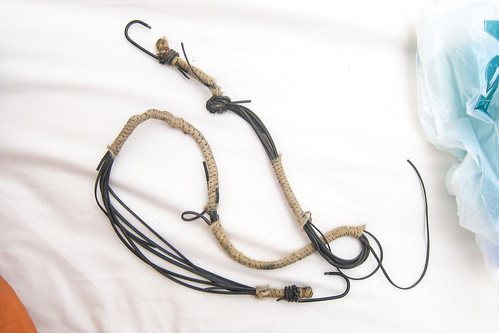
So, on July 11th, instead of cycling out of Windhoek towards South Africa, I show up at the French Embassy. My previous experience in Accra, and to a lesser extent in Yaoundé, left me with a bitter taste of the diplomatic French assistance. The opening hours for consular services are very limited to start with. At the Embassy itself, incredible security measures making it a mission to enter the building itself, followed by a poor reception, for finally no concrete result, describe a perfect recipe to waste one’s time. I understand also that the people there have to face daily hundreds of requests from West Africans trying to get into France, not always with honest documents, and would rather strictly filter the people. I guess Dakar and Abidjan are awful Embassies too. It’s in any case not as scary as American Embassies, easily spottable by armed guys everywhere blocking the whole roads for preventive security.
The difference is that Windhoek is much friendlier than these previous places: Namibia’s tiny population, and tinier tiny French community, makes the whole experience smoother. There is no security apart from a gendarme chilling in a booth, and it seems there is only one man receiving every visitor. The vice-consul is really helpful and confirms I would not be able to enter South Africa with my current passport. And he adds that consulates are not supposed to renew the passport of visitors, but only offers this service to local residents. Once again, I am proven that this world is not made for people who don’t have a residence, and who don’t have anything better to do than cycling just to see what’s after the next hill.
Unlike with the US passport, it’s not possible to add pages in mine, and one solution would be to make an emergency passport. It is issued within two days, but is valid for 1 year only. It means that, considering that a passport cannot really be used in its last six months of life, this emergency passport would only grant me six months of breathing space. It’s not the best solution.
Actually, the vice-consul is kind enough to renew my passport (it works the same way as at home, with the machine that takes fingerprints), but it takes at least three weeks (because the diplomatic courier is delivered only every two weeks). Since my Namibian visa expires in 40 days, the best and only plan becomes: I apply for a new passport here, then cycle until the border of South Africa, then take a bus or hitch-hike back to Windhoek (it should take one or two days), pick up my new passport, and drive again south where I left my bike, and enter into SA with my new passport.
Ouf, problem solved, and this way I remain in the legality and I won’t have to cheat (i.e. make a leg without cycling). Now, I can finally leave, with the bicycle, back to the desert!

I learnt my lesson on the C28 between Swakopmund and Windhoek: it is possible in Namibia to cycle on the same road for 6 days without meeting a single opportunity to get food. The C26 being more touristic, it should be possible to get food every 2 or 3 days at the small shops in farms or at campsites. But still, it’s not worth taking the risk to carry the supposedly minimum amount of food, so I leave Windhoek with 4 kg of spaghetti in my panniers, 500 g of droëwors, and plenty of other edible stuff.
With a population over 300’000, Windhoek is the largest city of the country. The closest city with more people seems to be … Johannesburg, approximately 1200 km away, closer to the Indian ocean than to the Namibian Skeleton coast. And how long does it take to get out of this big place? Less than 30 minutes, and I am already in the middle of nowhere once I pass the university, south-west of town.
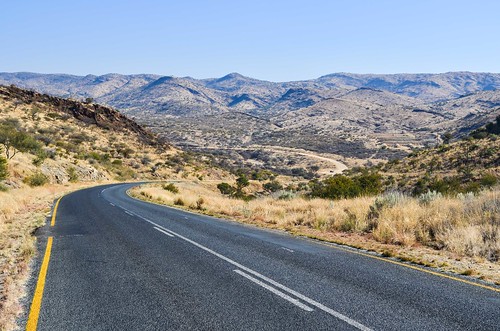
I picked this road not only to avoid the busy B1 highway, which is one of the few busy roads of Namibia, running north-south between Angola and South Africa, but also to pass by Sossusvlei, the D707 and the Namib desert. There should be no village but only sparse farms until Solitaire, if Solitaire is actually a village and not another farm.
There is a frustrating characteristic that all visitors to Namibia must have experienced: on most of the paper maps, the same circle is used to represent a small town of the north (with several supermarkets) and a simple farm in the south (which means there is a crossroad and water, but not necessarily a small shop). As a consequence, there is no way to reliably plan where to reload on food. At least I know that I will find one shop in Solitaire and one in Sesriem, so I can buy food every 200 km or every 3 days.

Windoek lies at 1700 m, and actually inside a high-up basin, in the middle of the Khomas Highland. My first kilometers of the day take me up to 2000 m via the Kupferberg pass, already on the dirt C26 road, since the tar lasted no more than 15 km since the city center. Once the smelly public waste dump site behind me, I can forget the “city” life and start on pushing my heavily food-loaded bike on the good gravel surface. It doesn’t take long to feel back into the wilderness.
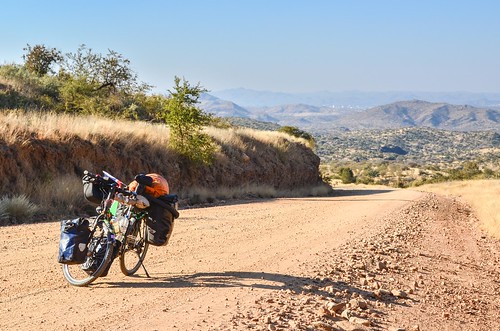
Unlike the deadly C28, the farms on the C26 are rather close to the road, and some even right on the road. It’s much easier to manage water this way.
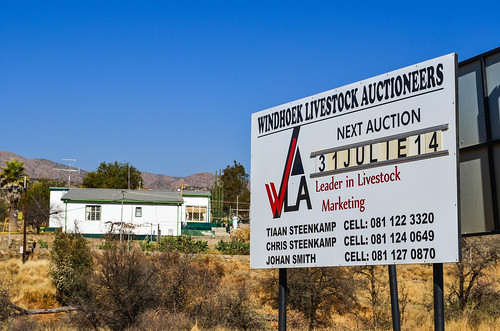
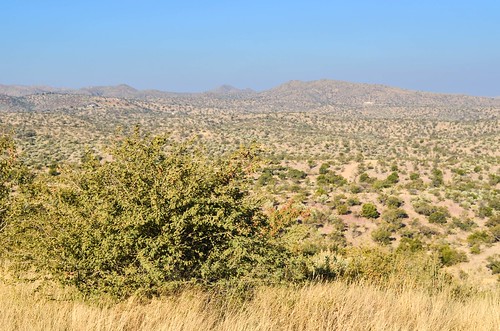
After almost a month off the saddle, I have to re-accustom my legs to their routine. That’s why half a day, 42 km and a push-the-bike gravel pass for a new start are enough.

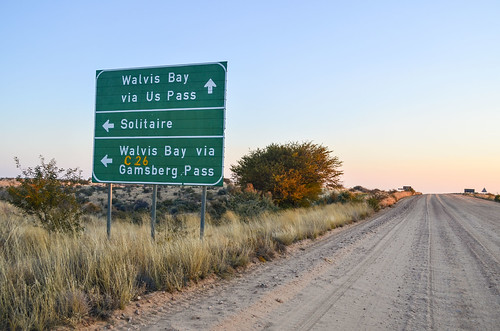
The top of the Highland is populated with baboons and warthogs, escaping from the road as I must be one of the few humans disturbing them today. As soon as the sun sets, I feel the elevation (1900 m) and the fact that I’m not anymore in a cozy apartment in town: it’s freezing. July is the coldest month of the year for this region, and here I am.
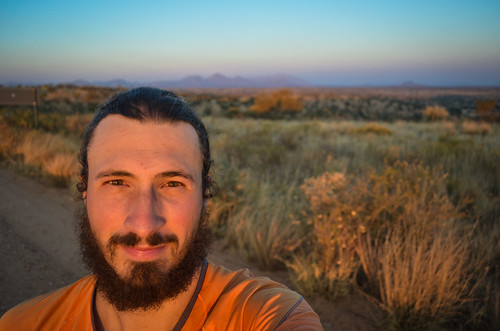
The night is not as cold (lowest in the tent: 5°C) as my coldest nights in the European winter, but I don’t sleep well. Either I became completely intolerant to cold after living for more than a year constantly above 25°C, or my equipment is letting me down. I have the same equipment as when I started in Switzerland though. Actually, I don’t have anymore my long johns and thick snowboarding socks, but the biggest difference may come from the mattress: the light and thin Thermarest mattress I had until Angola boasted a high R-value (heat transfer coefficient) and it might finally be more than a marketing tool.
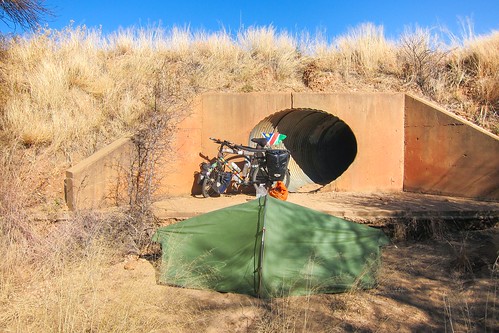
(Yes, I could have slept in the rainwater pipe, but it doesn’t protect from animals)
And indeed, it’s a good thing I put up my tent, as something wandered around in the middle of the night. I held onto my breath and it went away. I’d say it was a warthog or a monkey, but couldn’t find footsteps in the morning for identification.
When I tell the two farmers driving their pickup, beers in hand, that I am going to Solitaire, they reply: “Why are you cycling there? It’s too far. You don’t have gravel roads in France?“. That’s an answer I could expect from uneducated people in the country side, where people are foreign to the concept of travelling, but not in Namibia and on the way to the most popular destination of the country.
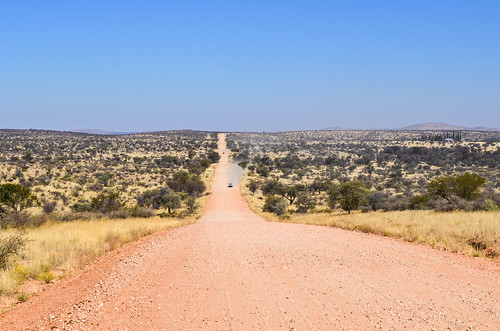
Well, let’s say that a bicycle is not the preferred way of transportation in this part of the world. The two men offer a beer, which I decline in favor of water, since after all, the sun is right above me.
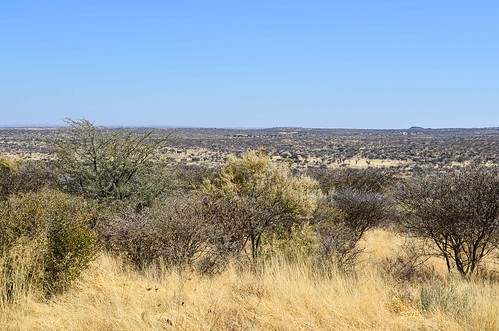
The most dangerous out here is the loose gravel on the road. It’s not really compact, neither a slow gravel road, it’s a compact dirt road with loose gravel on top. Smooth and with a turn every 20 km or so, it allows 4×4 drivers, with a beer in hand or not, to speed and project gravel everywhere. Even if the road is wide enough, I still cover my eyes, just in case, when I cross vehicles.
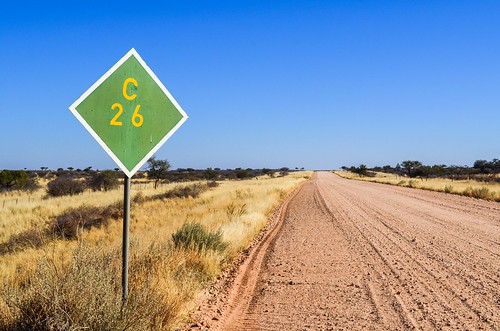
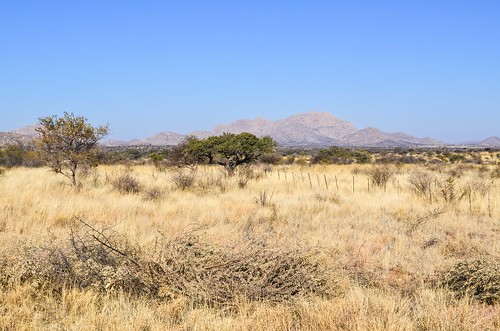
I don’t worry about reaching the first campsite for the night. It’s 40 km away and I have 3 hours left. I worry more about where to stop for snacking: there’s no shade anywhere. Freezing temperatures at night doesn’t mean that the sun is not burning during the day.


Completing the 40 km before the night is actually not that easy. The road is not rollercoasting as badly as near the Boshua pass, but it still makes me quite slow. The sun sets 10 km before I reach my goal and I decide to abandon it. It’s not really unsafe to cycle at night, but it will get really cold, and what if the campsite it closed? Then I’d have to find a hidden camp spot, at night, which is very annoying due to the farm fences.

From the top of my last hill, I spot two farmhouses by the road. I visit the first one but the fence is locked, so I head to the second one. It’s just after a sign reading “HESS”. Hmmm … so that big metallic structure on the other side of the farm is a telescope … it looks kind of a large red bridge from afar.
As I ask at the farmhouse for the permission to pitch my tent, the very friendly managers Sandra and Jürgen welcome me with boerewors and offer me to sleep in their spare bedroom. As I was very cold outside last night, I can hardly refuse.
They manage the farm, on the behalf of the owners. Buying a farm is quite costly, since apparently around here 1 hectare (100m x 100m) costs 3000 N$ (300 USD). It may sound like cheap land, but for a proper exploitation, with enough grass for enough cows, 5000 hectares are needed, i.e. a 1 M€ investment. Farms in the desert where nothing grows are cheaper, farms with too many rocks and koppies can’t be valued at the same price either.
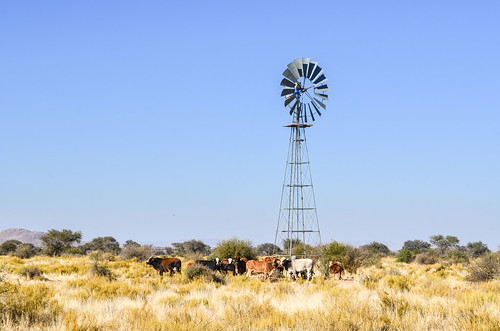
My hosts speak German. German is spoken as a mother tongue by 30’000 Namibians, and the only German newspaper in Africa is published here. However, more or less everyone speaks English, which is the only official language of Namibia. Namibia made there a different move than South Africa: post-apartheid South Africa declared their 11 main languages as official languages, instead of Afrikaans and English, the sole two official languages until 1994. On the other hand, Namibia picked only one official language, and to make the choice fair, it is a neutral language. English is neutral here as it “belongs” to none of the past occupants (the Germans and the Afrikaners) or the local ethnic groups (Ovambos, Kavangos, Damaras, Himbas, etc). And it makes it much simpler for the government to communicate in one language instead of eleven.
That said, there is no point for me trying speak German, and Sandra and I realize we know people in common: a colleague at Sandra’s workplace is the girlfriend of the friend of Mark who hosted me in Windhoek. Is it a coincidence? No, it’s just Namibia: the population is so small that the feeling that “everybody knows each other” is very frequent.
It reminds me of a story from Tsumeb. Freshly arrived in Namibia, I knew only three famous Namibians: the sprinter Frankie Fredericks, the Bushman of the movie The Gods Must Be Crazy, and the first president of the country, with his beard, Sam Nujoma. I met Hildegaard in Tsumeb who knew the first one, had worked with the second one (N!xau, who passed away), and remembers the third one when he was a tea boy in a farm. And it’s not the last time I meet people with whom this “Oh so you know X from <placename>?” happens!
Besides the cattle, the farm has two assets: first, there is a pet warthog, behaving and treated like a dog. Unfortunately I have no pictures, but as any baby animal, a baby one-year old warthog of merely 50 kg is cute. It comes for food and it doesn’t get scared at all by humans. During the day, it leaves the farm to play out with the wild warthogs, and comes back “home” at night for food and lodging.
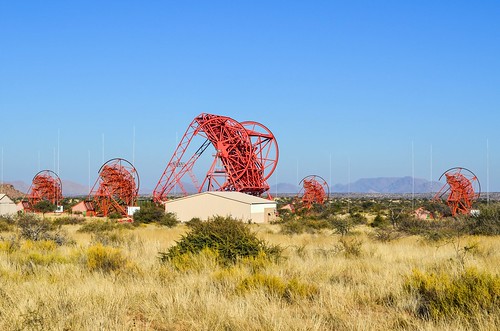
Second, the HESS telescope is actually on the farm itself, renting a small piece of land. Early morning, I get to pay it a visit, as it’s only 4 km on the track starting behind the farm. HESS stands for High Energy Stereoscopic System and it is a system of telescopes aimed at analyzing cosmic gamma rays. The complex is made up of 4 telescopes installed in 2002 and a fifth much larger one, operational since 2012, apparently all managed from the Max-Planck-Institut of Germany.
I hoped I could find someone there to explain me how does it work exactly, but being a full moon day, all of the five telescopes are turned inwards and there is no one on site (it looks like this when it’s working). It’s no surprise why such a telescope is installed here: the sky of Namibia has always been amazing, clouds are quite rare, and this part of the country boasts one of the best skies in the world in terms of light pollution (Class 1 on the Bortle scale).

Leaving my hosts after breakfast, I finally have to face a dilemma I couldn’t solve even with internet in Windhoek: which road to take to the Namib? From here it forks, on the right to the Gamsberg pass, and on the left to the Spreetshoogte pass. Both roads are scenic, downhill and I got as many people vouching for one as for the other. The former is the longest and the highest pass of Namibia, while the later is the steepest.
There are actually three mountain passes to reach the desert (Solitaire, Sossusvlei) from Windhoek: the Gamsberg, the Spreetshoogte and the Remhoogte. Windhoek and the Khomas Highland lie at 1800 m, and the desert is around 600 m. I know very well about the big elevation drop between both, as on my way from Swakopmund on the C28, I had to push hard on the 20% Boshua pass to get my bike on the other side.
I didn’t consider the third pass, Remhoogte, as it is the easiest one, the one generally recommended for caravans, trucks, and drivers without a 4×4.
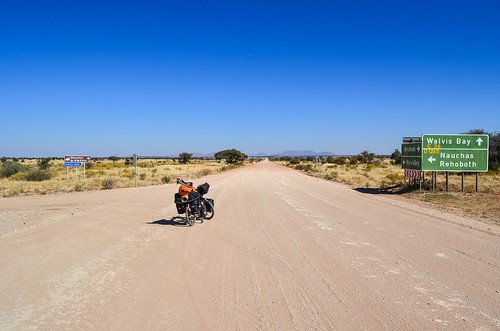
After 5 km only, I reach the junction where I have to make my decision about which road will carry me for the next two days. I have no doubt any of these roads will be fantastic, so I can only decide on the road surface quality. Hmmm … it’s roughly the same. Well, since the light wind comes from the north, let’s go with the wind. I pick the Spreetshoogte and pedal southward.
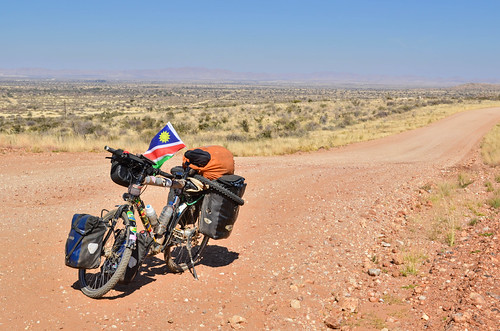
This road has relatively enough people living close by, that I can find water at least once a day, and it’s super nice! I didn’t think I’d ever say these words one day, but going through some tough conditions makes one appreciate simple comforts like a hot shower, a tar road, a water pump.
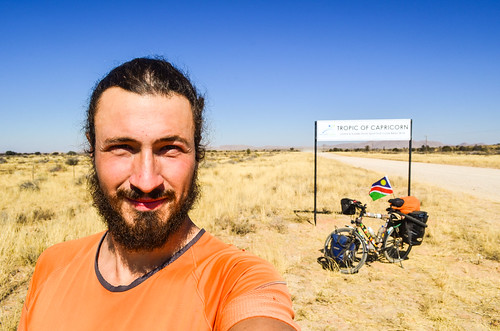
I meet a sign for the Tropic of Capricorn on the D1265 on the way to Nauchas. My GPS indicates 23°28′ instead of 23°26′, so there is an apparent 4 km offset. Actually, the tropic line is moving northward 15 meter per year, so these signs would need to be moved all the time to remain correct. For info, this is the consequence of one of the tree Milankovitch cycles, describing the fact that oscillations in the degree of Earth’s axial tilt occur on a periodicity of 41000 years from 21°5 to 24°5.
I was looking for it: in July 2014, it’s my third and last imaginary line, after the Tropic of Cancer in Western Sahara and the Equator in Gabon. I am now as south as Queensland, Australia. Bicycles can go far!

I’m ready for my lunch break but the sign doesn’t offer any shade. I have to cycle another 20 kilometers until I find decent shade to cook, and that is below a tree where hundreds of birds are nesting.
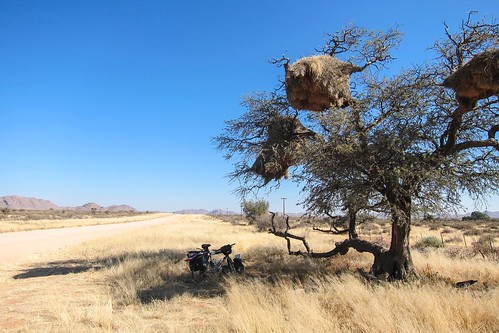
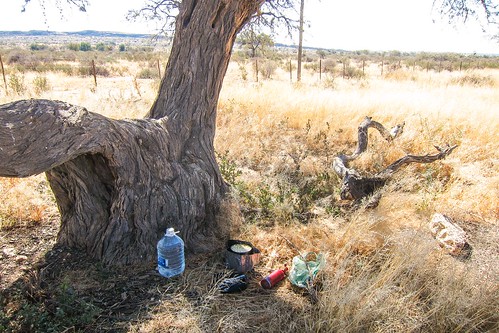
The road goes fine and I enjoy the slightly cooler ride of the late afternoon until Nauchas, when, 10 km before reaching this hamlet, my front tire has a flat. I’ll have to hurry if I want to make it before the night. Instead of changing the inner tube, I opt for the other solution, much lazier and almost as quick, to pull the inner tube out of the tire just where the puncture is, without removing completely one bead of the tire, without even removing the wheel, and patch it. It can work this way since I have spotted where the thorn had penetrated my tire.
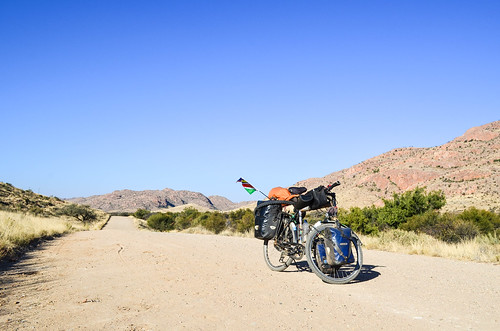
I pump it up and get ready to speed, but … my tire remains flat. Damn, it’s a double puncture. I’ve never had this, and it is now clear that I can’t reach my goal. No worries, this always happens, and in my misfortune, there is a farm-campsite only two kilometers behind. By the time I patch the second puncture, I lost enough time and the campsite will save me from having to find a suitable camp spot at dusk.
Once at the farm, and after more time wasted to find someone in there, I learn that the price is 130 N$, quite high for something that doesn’t look fancy. And because it’s now night, I have to follow the lights of the pickup of the farmer leading the way to the campsite, another 2 km away from the farmhouse.
Finally there, I am given firewood, and I understand why the price is above what my first impression deserved: these are “private campsites”. Every campsite is about 300 m from the next one, and has its own bathroom, own fire, and own shaded area. I must say the standard of accommodation in Namibia is quite high, when I see luxury lodges and fancy campsites in the middle of nowhere. It’s quite impressive how much care is put in setting up these camps, and in conjunction with the amazing landscapes, I guess very few of the tourists in Namibia face the chance to be disappointed (with the exception of the public tourism facilities, NWR, which have a monopoly in national parks).

After eating my spaghetti cooked on the fire, it’s time to enjoy a hot shower! The remoteness of the site explains why there is no electricity (even if many farms have installed solar panels attached to each campsite for hot water and electric plugs), but there is still a way to make hot water with the donkey.
The donkey is the name for the simple boiler that is often used to supply the showers with hot water in places without electricity. Like the bathroom, it is connected to a 5000L or 10000L water tank at the top of the koppie. You just burn firewood inside and the hot shower is ready within half an hour.
However the water is barely flowing, not even the cold one. Well, I quickly do the necessary to go to bed clean and warm. I’ll need to be warm tonight as the temperature will easily fall down to 5° in the tent, or lower. To add up with the double puncture and the donkey not working, I also realize I forgot my toothbrush at the farm this morning. I know, it’s not a big deal, but it’s still annoying. It’s only the second time I lose something on the journey. A towel in Morocco, a toothbrush in Namibia, and that’s it. It’s pretty good considered I change places almost every day.
I dress up for bed, with my clean and warm clothes, when … BAM! It sounds like the donkey exploded. Pssshhhhh …. orange flames and water are splashing all over the campsite. It looks like mini-fireworks, as in the night, the only light comes from the fire and the hot coals in the donkey. It could be beautiful, but it’s not. It’s an emergency situation: the water will soon flow on my tent, slightly downhill.
How come everything goes wrong for me in just a couple of hours? It’s really unfair, but no time to feel sorry for myself, I must stop that mess. Actually, the donkey didn’t explode, but the feed water pipe burst. There is no tap or valve anywhere. When showing me the place, the campsite owner had said something like “if you have any problem, just find me“. Right … there’s no network coverage and his farm is about 2 km away, and I’m not leaving my tent near a water jet while running in the darkness.

My mood quickly jumps from clean/warm/bed-time to emergency. I grab a steel rod, the one used to clean the ashes on the fireplace, draw a small trench in the sand around my tent, and build a small dike, to make the water flow directly below it. Because the water pipes are buried, it’s not easy to find where the water is coming from. There is little chance that I will find a tap in the bush, at night with a flashlight, so the safest is to run to the next campsite. I remember the owner had said something about filling my donkey from their campsite, so they must have a valve there.
A 500 m flashlight night sprint leads me to the neighbors and I ask them to close all the valves they can see. Indeed, the water tank is on the koppie on their side, so the water comes to their campsite first.
Pfiou … my tent is safe. The pond formed just near it will be absorbed during the night. My days are interesting enough, I didn’t need that adrenaline rush just before going to bed. In the meantime, I dig up the plastic pipe I just found near the campsite and break down a fitting, to be on the safe side. That would be ridiculous to be woken up during the night, in a flooded tent, almost in the desert.
I hope this new day will end the misfortune of yesterday, and that my tubes and tires will remain strong. Today I’m landing into the desert, but I have first to battle with a little bit of headwind on the gravel road through Nauchas.
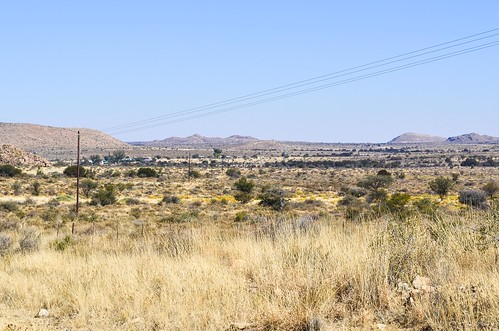
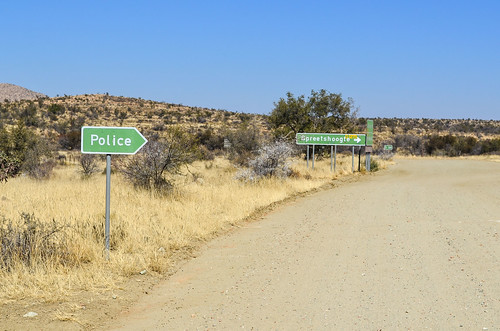
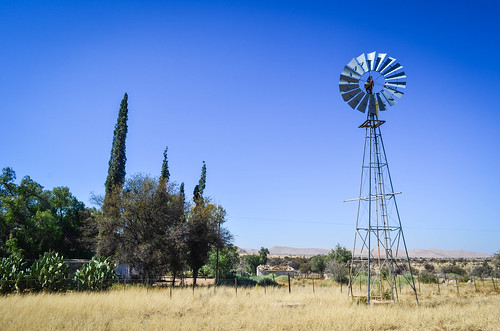
Nauchas is a simple junction, with a visibly abandoned campsite, some farmhouses, and a police station. Working in a police station with, let’s say, 100 inhabitants within a radius of 100 km, it must be a pretty relaxing job. The two roads from here lead to Solitaire: the D1261 on the left via the easy Remhoogte pass, and the D1275 on the right via the Spreetshoogte pass. That one has many warning signs against trucks and trailers because of “steep gradients”.
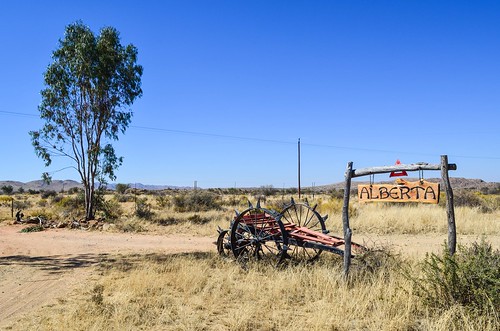

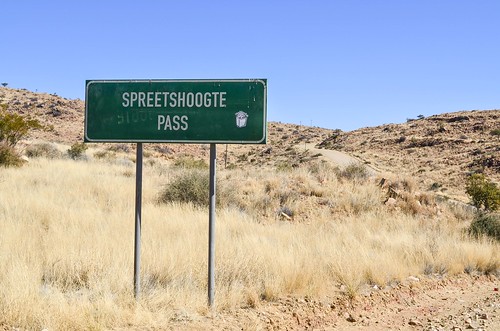
The pass is mostly downhill in my direction, but there’s a tiny slope to climb before getting to the top. And once there, it’s breathtaking. I was told “this pass offers a stunning view dropping right into the desert“, and it’s exactly that. But hearing it and seeing it for real are completely different. Coming from the gravel roads of the highlands, accustomed to rolling hills and to dry bushes, I never expected to be, all of a sudden, facing this massive drop: the surface of the Earth abruptly drops off 1000 meters and continues into a desert.
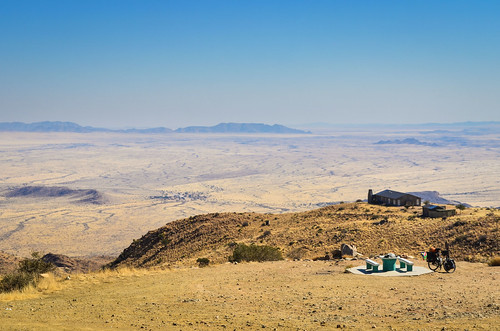
This is the steepest side of the Great Escarpment I have seen. It’s spectacular. The land is very dry and yellow everywhere. At the bottom, the Namib desert starts, criss-crossed by dry rivers beds and bushes following them. It’s simply fantastic, and I’m very happy I have taken this road. After a lunch break there, I will have to kill my brake pads going downhill.
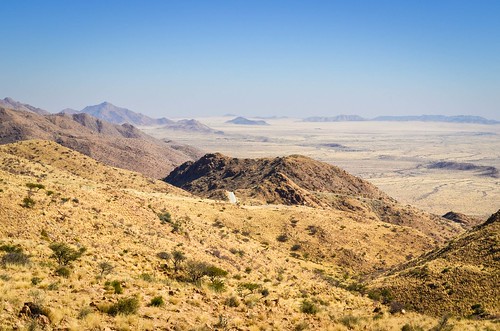

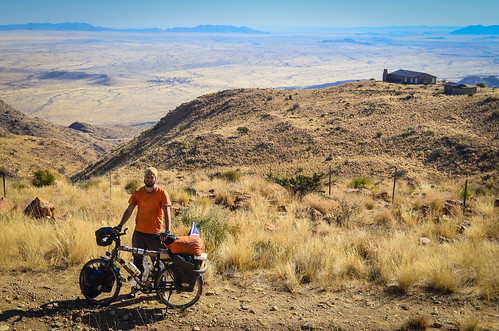
The pass itself has gradients up to 22%, making it the steepest of Namibia. I know how it feel to push a loaded bike on a 20% slope, so I know it would take me a good part of the day if I had to push my bike in the other direction, for only 5 km of road, but between 16% and 22% steep.
Accidents can easily happen if a 2WD with an average driver attempts to climb it, and accidents will happen if any vehicle takes it downhill without good brakes.
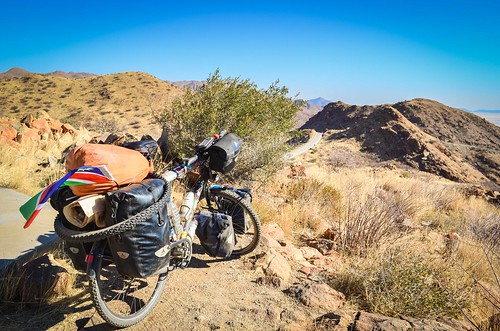
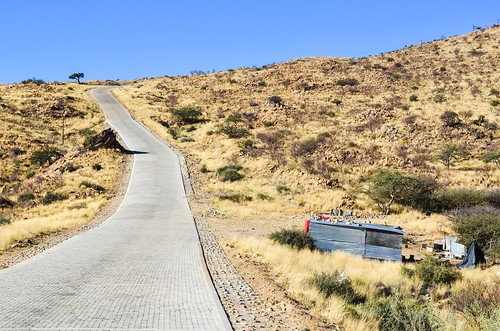


Like the Boshua pass, the steepest parts are paved with cobblestone, while the whole road is normally gravel. I’m glad about that, since I would in no way be that happy on a super steep pass if it had a bad surface. For people who want to break down some mechanics, the infamous Van Zyl pass in Kaokoland, northern Namibia, is surely a better choice.
There are two workers living in shacks midway, whose jobs is to repair the cobblestones. They must walk up the pass and carry the stones from a heap up there.

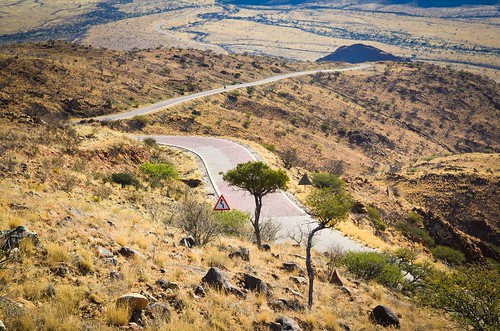
The pass trail is said to have been built by a farmer who lived just at the foot of the escarpment: whenever goods were delivered to his farm, they would be dropped at a bus stop at farm Namibgrens on top of the mountain. To gather them, the choice was to either travel via Remhoogte pass approximately 30 kilometers southwards, or to trek uphill along existing zebra paths. Spreeth decided to do the latter, fortifying the path with quartzite rocks whenever he undertook the journey. Soon the bright white rocks formed a line that could be spotted from a distance. Spreeth even catered for motor vehicles (not very strong at that time), placing long, flat patches of road ahead of every steep ascent. He built the pass literally with his own hands.
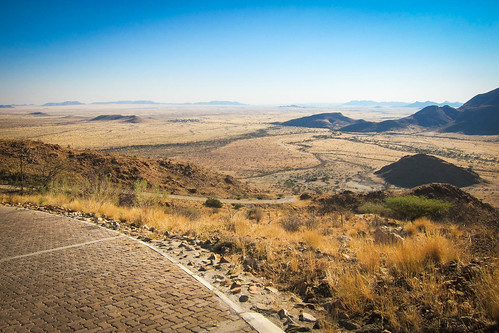

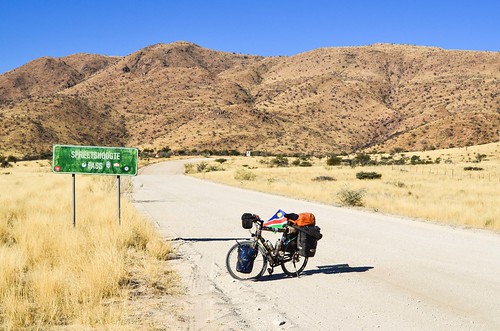
Once at the bottom, I know the nights will be significantly warmer from now on. It’s the first good news. The second good news is that the road through the savanna is fantastic: it’s flat, the scenery is amazing, and the sunset light makes the colors intoxicating!


I am aiming for Solitaire, where a well known bakery is said to be making the best apfelstrudel of the world (yes, in the desert). I travel fast with the smooth gravel, but Solitaire is still far. It’s 16:30, and I won’t be making these 30 remaining kilometers. I enjoyed too much sitting at the top of the Spreetshoogte and taking videos during the descent. It’s sad that I have to abandon the idea of an apple strudel (the saddest thing that can happen to me is something going wrong with food), but I will have it tomorrow.
As a result, I need more water for cooking and for lasting until morning. Luckily, there is a house by the road, empty, but with a water tank outside. This area in the Namib is definitely much friendlier than places in central Namibia, like remote Damaraland and the C26, for the many farmhouses visible from the road and for the campsites. It’s after all on the tourist trail. I even reduced my water load from 10L to 5L.
There are wild zebras on one side of the road, escaping up the koppie as I try to approach them for a decent photo with my wide angle lens. And these other animals that I didn’t miss at all, the annoying flies. The downside of feeling much warmer is that I’ll now have to deal again with flies running into my eyes and nostrils.
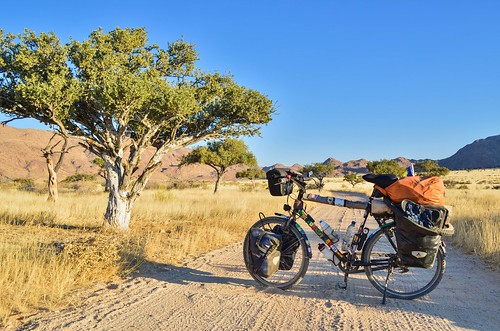
As I am refilling my water bottles, Willem stops by with his bakkie. The empty house is his, and he actually lives 3 km further in the farm, at the end of a valley. As I am looking for camping near the road, which is very impractical around here (farm fences all over), Willem offers to host me at his place. What I didn’t know straight away is that his place is also a lodge, one of these fancy lodges, very comfortable, in a pristine landscape: the Barchan dune retreat.
He says “you can put your bike with me in the land rover for 3 km, but I know you cyclists always refuse and always want to cycle every bit“. Oh you know? It’s very true. I’m not sure if every other touring cyclist refuse lifts, but for sure, I always do. Why actually? Is it because I find worthless to “cheat” for a few kilometers when I already cycled thousands? Or because I find it annoying to unload the panniers and too risky to have my bike bouncing in a vehicle on a rough road? Or maybe it’s the laziness of having to unload it and stabilize it in a car, while riding it is simply my routine.
Not visible from the road, but hidden in a fantastic location in the rear of a valley, slightly elevated, with a view extending far away, the lodge does everything on its own: electricity, water, and game meat. Willem and his wife built everything from scratch, invested in solar panels (an investment returned in 3 years), and decorated with a good taste. The bungalows for guests are well integrated in the nature, I didn’t even noticed them at first. I don’t reach the farm as quickly as I thought, these last three kilometers being eventually ascending and in the sand. But my super kind hosts make me instantly forget that I wanted to reach Solitaire.

The piece of land they own is a small farm, by Namibian standards: only 4000 hectares. All the guest being around the table, we talk about everything and anything, and compare the countries we have traveled. Around the table sits Yannick from the Valais, Switzerland, walking for weeks every remote mountain of the region and staying at local farms (by the way, being a school teacher in Switzerland is indeed a very nice job for long and expensive holiday seekers), so we can collaborate in comparing lifestyles in Switzerland and Namibia. Basically, from a white farmer’s point of view, in Namibia (a comment probably also extending to South Africa), the government will not do anything for you: make your own roads, drill for your own water, arrange for your own electricity, and if a bad year happens, if the rain doesn’t fall, it could be terrible for you. On the other hand, there’s no rules and no authorizations needed. If you want to build a 200 m high tower in your farm, there’s no permit required.
I also heard another viewpoint on the Herero genocide by the Germans in 1904. I was talking about it when I cycled pass the Waterberg, in the north-east of the country, where the battle took place. What history doesn’t say is how the Germans, freshly installed in Namibia, gained possession of all the Herero cattle and land, which led to the revolt. Apparently, the Germans around the Hereros first were not soldiers but traders. And they sold alcohol. The Hereros began to like it too much and progressively paid with their cattle when they couldn’t afford it anymore. Then, with no more cattle, they paid by giving their own land. And once they realized they drank all their assets, the only way to survive was to revolt, kill the traders, and recover their land. But when the German soldiers arrived at the Waterberg (to kill them all), the Hereros fled towards Botswana, running unprepared into the Kalahari, and died from thirst. That story softens a tiny bit the crude genocide history, but the proofs against the Germans can’t be ignored. As always, the truth must lie in the middle …

While showering, I find in my hair a big red flat fly, one of these flies that bite hard. I already found this morning in my hair another spider-like insect, and earlier a dead tick on my neck, hidden in my beard. That’s one serious drawback of long hair!






I started out googling some info on the road between Swakopmund and Windhoek, happened upon your blog and couldn’t stop reading for the past few hours! If you’re ever in Namibia again, I’ll be happy to host you!
Congratulations on completing this marvelous adventure! After I discovered your site, I’ve spent the better part of the day reading everything. So.. what’s up next? Zurich will probably be very boring for you. And what was your job before your trip? Do you miss it?
I very much like the type of music that supports your vimeo clips. It is probably a good reflection of your positive attitude 😉
Thanks! Look in the coming weeks for the next vimeo clips.
What’s next? … hum, hopefully a boat back to Europe and an interesting occupation? It’s open 🙂